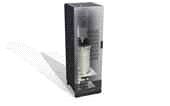Consumables
Lower Frequency of Dampening Solution Changes Cuts Costs and Is Kind to the Environment

Wednesday 29. April 2009 - Heidelberg moves into filtration technology with FilterStar and FilterStar Compact
Heidelberger Druckmaschinen AG (Heidelberg) now offers the ideal solution for keeping dampening solutions clean for longer periods – with the FilterStar and FilterStar Compact filtration systems. FilterStar Compact is designed for the Speedmaster SM 52, SM 74 and XL 75, while FilterStar is employed in the larger presses. Each of these systems cleans the dampening solution continuously and protects it against the coarse impurities in the form of ink and paper particles. FilterStar Compact extends the service life of dampening solutions from two to twelve weeks, depending on the alcohol content, and the print spectrum to between four and six months. FilterStar even extends this period to between six and twelve months. The savings generated by the elimination of non-productive dampening solution changes and lower disposal costs are considerable. In most cases, the investment pays off within two or three years. In addition to the effect they have on the environment and the pocket, contaminated dampening solutions also have a negative impact on print behavior – the plates do not run as smoothly and the ink/water balance becomes much narrower. The stop-gap solution used in the past was to change the dampening solution, which involved production downtimes of up to an hour.
FilterStar is now available worldwide, while FilterStar Compact is available for Germany now and for the rest of the world from mid-2009.
Details
New quartz filtration with FilterStar Compact
FilterStar Compact from Heidelberg is a cost-effective quartz-based filtration system for dampening solution. The water is drained continuously from the dampening solution tank and passed through a single-stage quartz filtration system. The contaminated dampening solution is pressed through a mix of various quartz crystals at high pressure. Paper coating and ink particles up to five micrometers attach themselves to the crystals and are thus removed from the water. Instead of users disposing of the quartz mix themselves, Heidelberg recommends they return used cartridges with the quartz mix to the manufacturer after four to six months. The manufacturer will dispose of the waste professionally and refill the cartridges. This solution is a further benefit for the environment, because the cartridges can be reused several times.
Two-stage filtration with FilterStar
FilterStar employs a two-stage filtration system. The coarsest impurities are extracted using a pre-filter comprising seven tubes. A large surface area increases its efficiency. The main filter comprises 16 discoid layers and captures all particles measuring down to one micrometer. This method filters out impurities, while ensuring that key components, such as corrosion inhibitors, remain in the dampening solution. The filter is also equipped with oil absorption features, so that small splashes of cleaning agent no longer result in the dampening solution having to be changed immediately. The filter is usually changed at the same time as the dampening solution, i.e. every six to twelve months, and the process usually takes between 30-45 minutes. Used filters have to be disposed of as ink-soiled waste.
“We have already installed more than 100 of these filtration systems in a very short period of time. The feedback from our customers is positive across the board and printers wouldnt be without these systems now. Whats more, they generate significant cost savings for print shops,” underlines Eike Frühbrodt, Head of Peripheral Product Management at Heidelberg. He continues, “I wouldnt be surprised if filtration systems for dampening solutions were to become standard equipment in all presses in the next few years. They can also be retrofitted easily to existing machines at any time – and it makes sense to do so.”
For greater ease of operation and control, FilterStar – just like all the Star peripherals – is integrated into the press via CANOpen. In this way, a contaminated filter is indicated directly on the Prinect Press Center control station of the Speedmaster press. FilterStar from Heidelberg is recommended particularly for alcohol-reduced and alcohol-free printing, as a constant ink/water balance is essential for successful production in this case.
Filtration technology represents a further step towards sustainable printing
Heidelberg is committed to achieving its goal of sustainable printing. FilterStar Compact and FilterStar are making an important contribution to environmental protection because the tanks and tubes have to be cleaned with chemicals less frequently and there is less dampening solution to dispose of.
Heidelberg made environmental protection a corporate objective back in 1992. This issue has continued to gain in significance, proving time and again that sustainability and economic success are not mutually exclusive. It is for this reason that Heidelberg has set up a dedicated area on its website, which provides a whole range of information on the subject of sustainability – HEI ECO website.
